One of the sweetest gooseberry varieties is Candy.
Candy gooseberry is one of the sweetest varieties, obtained by breeders relatively recently. We will analyze in detail the advantages and disadvantages, characteristics of the variety and the technology of its cultivation.
What kind of gooseberry is this?
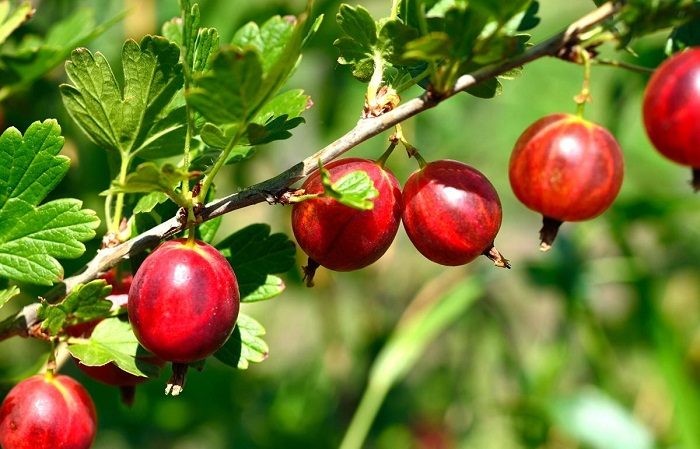
Candy is an unpretentious and frost-resistant delicacy variety that, if you follow the care instructions, gives an excellent harvest. It belongs to the mid-season, although some gardeners classify it as a late crop. Ripening times may vary depending on the weather and region.
Brief history of origin and distribution
The variety was obtained at the South Ural Research Institute of Horticulture and Vegetable Growing by a breeder from Yekaterinburg, V. S. Ilin. In 2008, the Confetny variety was registered in the State Register of the Russian Federation. This gooseberry is intended for cultivation in Western and Eastern Siberia.
Characteristics and description of bushes
Gooseberry bushes of the Candy variety reach up to 1.5 m in height, and the root system is shallow - up to about 30 cm. The branches and shoots extend vertically and create a small, neat green shape. There are small brown thorns on the lower shoots. The leaves of the plant are five-lobed, shiny, and medium in size.
The berries of the variety are very beautiful - pink-honey color with light veins. The fruits are large, weighing up to 6 g, the pulp is tender, has a delicious taste with slight sourness and an average seed content.
The variety is high-yielding - up to 6.5 kg of berries can be harvested from one bush.
Reference. Candy gooseberries begin to bear fruit a year after planting.
Temperature resistance
Gooseberries of this variety are frost-resistant, tolerate temperatures down to -29°C. The plant can also survive short-term frosts below -30°C. The safety of gooseberries depends on the quality of their preparation for winter.
Moisture and drought resistance
The Candy variety has a high drought resistance and other adverse weather conditions. But gardeners need to remember that since the main part of the root system is shallow, prolonged drought will negatively affect the quality of the crop. Such conditions are especially undesirable during the gooseberry flowering period. Therefore, it is necessary to control the soil of the plant - it should be moderately moist and not too dry.
Prolonged rains can also affect the number of ripened berries.
Resistance to diseases and pests
Candy gooseberry is highly resistant to diseases and pests. But it is worth noting that this immunity is preserved provided that the plant is properly cared for.
From diseases to a small extent the variety is affected by powdery mildew and anthracnose; susceptibility to septoria is much higher.
Among insects, sawflies, moths and other garden pests can harm the plant. To prevent this from happening, and for the gooseberries to grow and bear fruit, every spring carry out preventive spraying with “Fufanon” or karbofos solution. It takes 1-1.5 liters of the drug per bush.
Characteristics and description of fruits

The berries of the Candy variety are considered one of the most delicious and sweet. They are large and one-dimensional in size, round-oval, with an average weight of 4-6 g.The skin is very thin and pubescent, the flesh is transparent greenish, has an unusually sweet, delicious taste and a persistent pleasant aroma.
Berries are rich in vitamins and iron.
Application area
Gooseberries are consumed not only fresh. This variety makes delicious homemade preparations - preserves, jams, marmalades and even compotes. The berries tolerate freezing well and can be stored in the refrigerator for up to two months. After defrosting, they retain their appearance and taste characteristics.
Attention! Gooseberries of the Candy variety can be eaten at any stage of ripeness.
Advantages and disadvantages of the variety
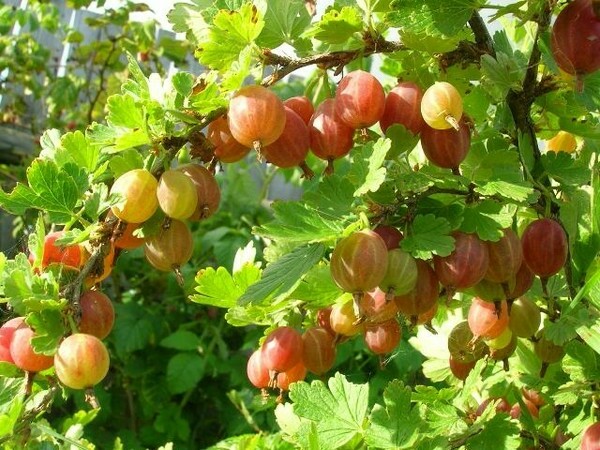
According to reviews from gardeners, Candy gooseberries have a number of advantages:
- sweet delicacy taste;
- high productivity;
- resistance to weather conditions - frost and drought;
- good resistance to powdery mildew and anthracnose;
- does not require pollination;
- compact bush size;
- a small number of thorns;
- the berries do not fall off when ripening;
- universal use of berries.
The only disadvantages of the variety are:
- demands on soil composition;
- low resistance to septoria.
Growing technology
The quality and quantity of the harvest depends on the correct adherence to agricultural technology when planting and caring for the plant.
Optimal conditions
The area for gooseberries must meet a number of requirements:
- sunny and protected from the wind;
- loam with a slightly acidic reaction;
- groundwater at a depth of at least 80 cm.
It is better to take a two-year-old seedling with elastic roots and undamaged shoots.
Landing dates and rules
Experienced gardeners know that if you plant gooseberries 1.5-2 months before frost, they will take root better and bear more fruit.But in regions where frosts begin early, it is better to plant the plant in early spring, before the buds open.
Before planting, it is recommended to cut off the top of the seedling, leaving no more than five buds. The day before, you need to soak the roots for a day in sodium humate, a growth stimulant, for example, “Epine”.
The selected area requires certain preparation before planting - the soil must be enriched with nutrients. After planting, the gooseberries will absorb them along with moisture.
Planting is carried out according to the following algorithm:
- the distance between holes is 1.5 m, row spacing is at least 2 m;
- depth and diameter of the hole for the seedling - 50 cm;
- the excavated soil is mixed with 50 g of superphosphate, 40 g of potassium sulfate, half a glass of ash and a quarter bucket of manure;
- the seedling is lowered into a hole, the root collar is buried 5-6 cm;
- sprinkle with soil and compact thoroughly so that no free cavities remain;
- the plant is watered and mulched with peat.
If you properly apply fertilizer when planting gooseberries, they will not need additional feeding for two years.
Further care
Subsequent care is not complicated; it includes standard measures: pruning damaged branches, watering and fertilizer.
In the spring, when sap flow has not yet begun and the buds have not swelled, it is necessary to trim off all damaged areas. In the fall, branches that are more than six years old are cut off - there will be no harvest on them.
Pruning is carried out annually. By removing old and dead branches, the plant receives more light and air. The procedure stimulates the growth of new young shoots.
Attention! The cut areas must be treated with garden varnish.
For the bush you need to build a circular support that will support the side branches.
Water the gooseberries as needed with settled warm water; the soil should be moderately moist.
In order for the crop to grow better, in May you can enrich the soil with organic matter, potassium or nitrogen fertilizers.
Possible problems, diseases, pests
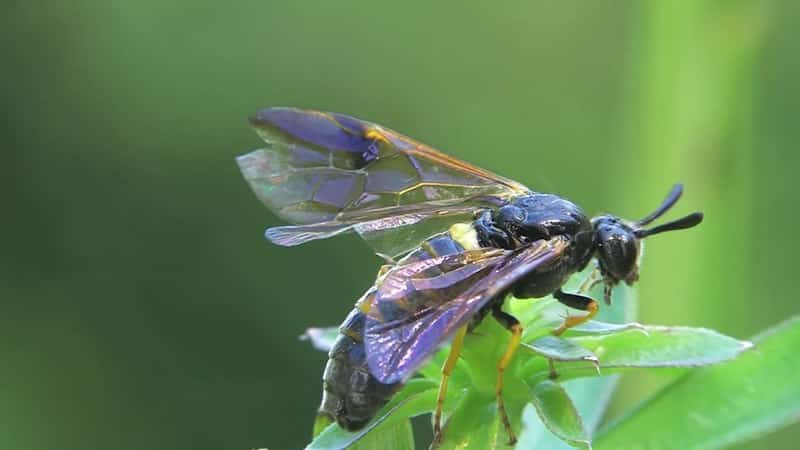
To destroy the larvae of sawflies, moths and other pests, immediately at the beginning of spring it is necessary to pour boiling water over the bushes. This is an effective folk method for preventing pests and diseases. This can only be done in early spring, before the buds wake up, so as not to ruin the plant. You cannot pour boiling water on the bush itself - hot water is used either for spraying or for root watering. One bush requires about 3-4 liters of water.
After this, special insecticides or biological products, such as Aktara, Akarin, Entobacterin, are used as necessary. When processing, you must strictly follow the instructions on the packaging.
Attention! Treatment with chemical insecticides can be carried out no later than a month before harvest, with biological products - two weeks.
If the plant is damaged by fungal diseases, but before the buds open, the gooseberries are sprayed with Bordeaux mixture or copper sulfate. The procedure is carried out in the spring, during budding, and in the fall, after leaf fall. Prepare a 1% solution at the rate of 1.5 liters per bush. A maximum of three treatments can be carried out per season.<
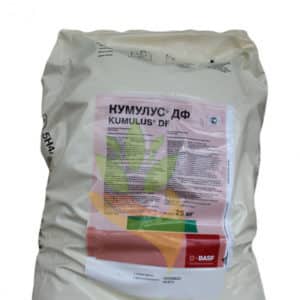
If traditional methods do not help, you can move on to the “heavy artillery” - chemical fungicides, for example, Vectra, Cumulus or Nitrafen No. 125. When using fungicides, it is important to strictly follow the instructions on the package so as not to ruin the gooseberries.
Features of growing varieties depending on the region
Candy gooseberry is adapted for cultivation in the East Siberian region. But it can be bred throughout Russia.
There are no particular differences in the cultivation of gooseberries in different regions. In warmer climates, harvesting can begin as early as June, in northern climates - from the end of July.
There are also slight differences in preparing the plant for wintering - in cold regions, better shelter for the gooseberries is required.
Pollinator varieties
A very important advantage of the Candy variety is self-fertility. This variety does not require pollinating plants.
Wintering
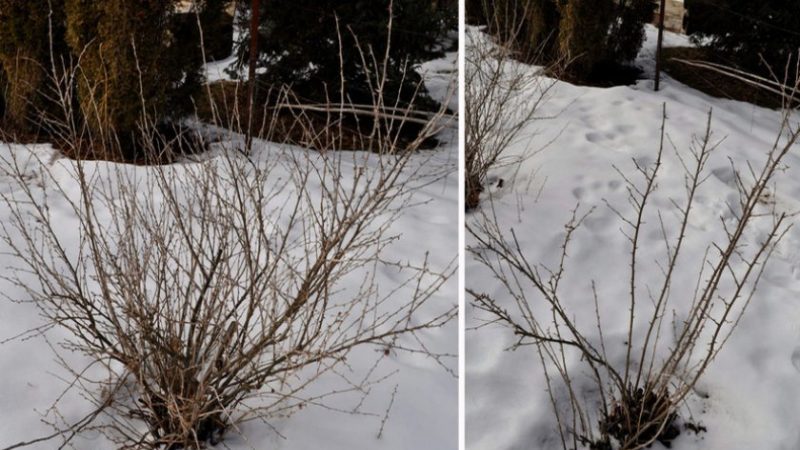
Proper preparation of the plant for winter depends on whether it will withstand the winter or suffer from severe frosts.
In autumn, gooseberries need to be watered generously - this will increase the winter hardiness of the plant. An important point is fertilizing, for example, with “Autumn” fertilizer. As a preventive measure against diseases and pests, the crop can be shed with a slightly diluted solution of potassium permanganate.
Before wintering, old branches are cut off, and the tree trunk circle is mulched with humus or peat. For the winter, gooseberries are wrapped in covering material, and in the event of a snowy winter, covered with a snow cushion.
Reproduction
Gooseberry Candy reproduce in the same way as other varieties - by cuttings, seeds, dividing the bush or layering.
The simplest and most popular methods of propagation are cuttings and layering.
Cuttings are carried out in early spring. Young shoots with 5-7 buds are carefully cut off and placed in any root formation stimulator, for example, Kornevin, for a day. After this, they are planted in a substrate of peat and sand mixed in a 1:1 ratio, and periodically watered to keep the soil moist.By October, the cuttings have time to take root, after which they are transplanted into special mini-beds for growing.
Reproduction by layering is also carried out in the spring. The lower branches are attached to the ground and sprinkled with soil, leaving a small area with 5-6 buds on the surface. The place of contact with the ground is well shed. By autumn, such a layer will take root, it can be carefully separated and transplanted into a school for growing.
Reviews from summer residents
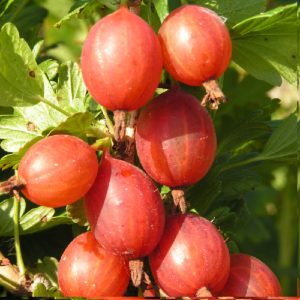
Judging by the reviews of gardeners who have already harvested gooseberries of this variety from their plots, Candy, although a young variety, is already loved by summer residents.
Elena, village Winter road: “There are several different varieties of gooseberries on my plot, but my favorite is Candy. We eat it fresh, and I make very tasty marmalade for the winter.”
“The taste of this gooseberry cannot be confused with any other. And the fact that it is disease resistant makes it even more attractive. There are three different varieties on my site. Candy, unlike others, has never been affected by powdery mildew in so many years.”
Conclusion
Candy gooseberry has already earned the trust and love of gardeners. Its unpretentiousness and wonderful taste attract many. But still, in order not to be disappointed, it is necessary to follow simple rules of agricultural technology and crop care.